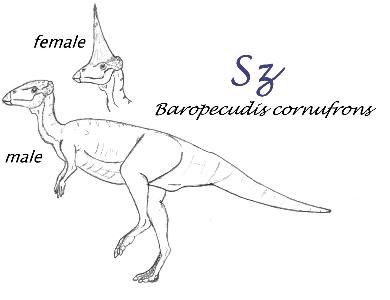
One of the most perplexing puzzles of Specworld's
fossil record concerns the disappearance of the pachycephalosaurs. These
thick-skulled ornithischians, commonly referred to as "boneheads" or "pachys",
first appear in the Barremian of Europe and for the rest of the Cretaceous
form a minor component of most terrestrial fossil assemblages in Asia and
North America. On Spec, despite having been spared the sudden annihilation
of their Arel counterparts at the K-T, the boneheads do not last very far
into the Cenozoic.
Baropecudis, informally known as the "Sz", is one of several fascinating fossil forms discovered by Clayton "Reedstilt" Bell's expeditions to Central Asia.This 2 metre long pachycephalosaur, known from several complete skeletons, is notable for the long horn found on some adult skulls. No other bonehead is known to have possessed such a horn although the rest of the anatomy suggests that the Sz (Malaysian for "unicorn") is a derived homalocephalid.
Surprisingly, it seems that only the adult FEMALES possessed this horn, a conclusion based on skeletal morphology and the presence of shell fragments in the abdominal cavity of three horned individuals. Why the females should have such an lethal-looking horn is unclear. Perhaps the females were responsible for anti-predator defence whilst the males fought amongst each other for mating rights with their conventional pachy-heads.
Based on the curvature of the eggshell fragments, it appears that the mother Baropecudis laid only one or two enormous eggs akin to that of an Arel kiwi. The pelvic region of the females was laterally expanded to allowthe passing of such a monstrous object which in life may have been about 25cm at it's longest and 15 cm at its widest.
Importantly, the deposits from which the fossils were excavated are believed to be of either Late Paleocene or Early Eocene in age. If so, this makes it the youngest known pachycephalosaur on Spec. Elsewhere, the boneheads vanish from the fossil record midway through the Paleocene for no apparent reason, a fact made more confusing by the relative abundance of pachycephalosaur fossils in Early Paleocene sites throughout the Northern Hemisphere.
Some Late Maastrichtian deposits (Like the Sandy Site of Arel's South Dakota) would seem to suggest that the pachys were doing quite well despite everything going on around them at the end of the Cretaceous. Early in the Paleocene, boneheads are relatively common throughout the Northern Hemisphere (represented by at least four genera worldwide) and are often the only non-avian dinosaurs represented in some fossil assemblages. Then, as the Paleocene progressed, something went very wrong. While other small ornithischians began to diversify, the boneheads suddenly vanished, with only Baropecudis surviving till the end of the epoch.
Just what could have happened to bring about the demise of the boneheads in such a short space of time has become a hotly debated topic. The fact that they failed to radiate despite a noticeable lack of competition might suggest that the Paleocene pachycephalosaurs were somehow specialised in ways unknown to us. Their fall would seem to coincide with the diversification of other groups like the protoceratopsians which might have outcompeted them. Or perhaps their breeding habits, assuming that the other pachys laid small clutches like the Sz, left them vulnerable to nest predation. It has even been speculated that their brief success was directly tied in with the conditions of the Late Maastrichtian and earliest Paleocene which so many other species found to be detrimental. When the "bad times" ended they found themselves unable to adapt to the "good times".
The fact of the matter is that we simply do not know what happened to Spec's boneheads.